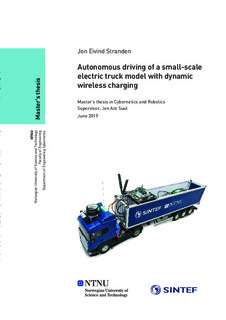| dc.description.abstract | Automated wireless power transfer can be seen as an enabling technology for autonomous
vehicles. At SINTEF Energy Research a 1/14 scale electric truck model [13] had been
used for demonstrating such technology. The truck was fitted with an induction system,
but was otherwise stock. In this master thesis a system for autonomous path following has
been developed and successfully implemented to demonstrate self-driving capabilities on
a path that includes an inductive charger. The purpose of the vehicle is to visualize the
concept of wireless charging for a self-driving truck, but on a smaller scale.
Three different methods has been tested and implemented.
1. A LiDAR-based approach that utilizes Hector SLAM for mapping and localization
together with a Pure Pursuit and Stanley Steering path tracking steering controller.
2. A machine-learning and camera-based approach that can navigate a track using deep
learning and behavior cloning/supervised learning. This was inspired by the convolutional
neural network used in Nvidia’s DAVE-2 self-driving car.
3. A classic computer vision approach for detecting lane curvature and using PID for
control.
ROS nodes that integrates the output from the SLAM- and deep learning-methods and
combines them with a path recorder and a path tracking algorithm has been made, together
with a graphical interface for monitoring vehicle states. Methods for estimating odometry
without wheel encoders, dynamic speed control and obstacle detection with start/stop
functionality has been implemented, along with a computer vision method for detecting
ArUco markers. A complete, self-driving ROS-based system has been created. An Nvidia
Jetson TX2 has been used as the main embedded computing unit. The system implements
Hector SLAM as the primary SLAM method, since it does not require odometry. The
Pure Pursuit path tracker was chosen as the preferred steering controller since it resulted
in smooth and stable tracking of the path. The neural network of the machine-learning
approach was able to steer the truck reliably and is implemented in the final version as
a separate mode. This works independently of the LiDAR for when the LiDAR is out
of range. The neural network has also been tested on the Udacity self-driving simulator
[4]. The computer vision approach was found to be too demanding for the embedded
hardware, and ended up not being used. The inductive charger system has successfully
been connected and integrated to the Jetson TX2 through a CAN-bus interface in order
to receive the battery state. The amount of charge received is dependent on the positioning
of the truck, and is not optimized for a system with manual path creation. A better
autonomous positioning system when driving across the charger is recommended, along
with a better and more precise LiDAR and vehicle platform. | |
